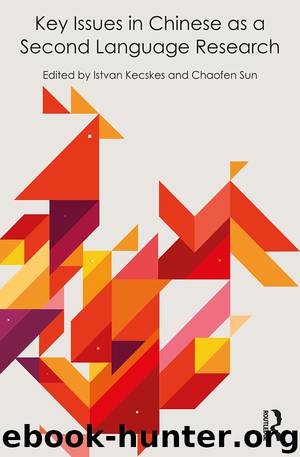Key Issues in Chinese As a Second Language Research by Istvan Kecskes Chaofen Sun

Author:Istvan Kecskes,Chaofen Sun
Language: eng
Format: epub
Publisher: Taylor & Francis Ltd
2 Chinese Nouns and Issues With the Grammatical Marker de 的
Wang (1990) reported that the average length of words in the PRC Chinese public school textbooks is 1.98 characters long. In other words, Chinese words are typically two-syllable long, as each Chinese character essentially stands for one syllable. However, the token occurrences of the one-syllable words only make up 52.7% of the texts in the PRC public school textbook corpus. Tao (2015), in still another corpus study, found that among the most frequently used 1,000 and 100 Chinese words, the token rates, at the text count level, of the monosyllabic words are 72.2% and 82.3%, respectively. That is, one-syllable words are still dominant in the present-day Modern Chinese. For example, there are three monosyllabic words, 他, 很, and 好, in (1a), and the most frequently used words are just like them. Furthermore, there are also three words, 他们, 是, and 好人, in (1b), but two of them are disyllabic words in the Chinese lexicon with relatively lower occurrence frequency. Booij (2007) observes, “So we have to make a distinction between the notion ‘word’ in an abstract sense (lexeme) and the notion ‘word’ in the sense of ‘concrete word as used in a sentence’” (p. 3). In this light, the pronominal 他 in (1a) that can be used alone as a word is then a more abstract-free morpheme. However, 们 that cannot take up the place for a word in a sentence all by itself without another morpheme (or lexeme) such as 他 in (1b) is then a nominal suffix, or bound morpheme, signaling plurality (for human nouns only). In (1b) 他 is qualified by the suffix 们, and 他们 as a complex word together are used in the sense of a word in a sentence. However, it is still not entirely clear if 好 + 人, with a [modifier + head] structure composed of two free morphemes, is a compound word or a phrase made up by two words 好 and 人. In this chapter, a new model is proposed to properly understand this kind of Chinese [modifier + head] nominal construction.
Download
This site does not store any files on its server. We only index and link to content provided by other sites. Please contact the content providers to delete copyright contents if any and email us, we'll remove relevant links or contents immediately.
Cecilia; Or, Memoirs of an Heiress — Volume 1 by Fanny Burney(32372)
Cecilia; Or, Memoirs of an Heiress — Volume 3 by Fanny Burney(31749)
Cecilia; Or, Memoirs of an Heiress — Volume 2 by Fanny Burney(31714)
The Lost Art of Listening by Michael P. Nichols(7359)
Asking the Right Questions: A Guide to Critical Thinking by M. Neil Browne & Stuart M. Keeley(5577)
We Need to Talk by Celeste Headlee(5496)
On Writing A Memoir of the Craft by Stephen King(4820)
Dialogue by Robert McKee(4272)
Pre-Suasion: A Revolutionary Way to Influence and Persuade by Robert Cialdini(4093)
I Have Something to Say: Mastering the Art of Public Speaking in an Age of Disconnection by John Bowe(3816)
Elements of Style 2017 by Richard De A'Morelli(3280)
The Book of Human Emotions by Tiffany Watt Smith(3197)
Fluent Forever: How to Learn Any Language Fast and Never Forget It by Gabriel Wyner(2988)
Name Book, The: Over 10,000 Names--Their Meanings, Origins, and Spiritual Significance by Astoria Dorothy(2909)
Good Humor, Bad Taste: A Sociology of the Joke by Kuipers Giselinde(2855)
Why I Write by George Orwell(2851)
The Grammaring Guide to English Grammar with Exercises by Péter Simon(2681)
The Art Of Deception by Kevin Mitnick(2662)
Ancient Worlds by Michael Scott(2576)
